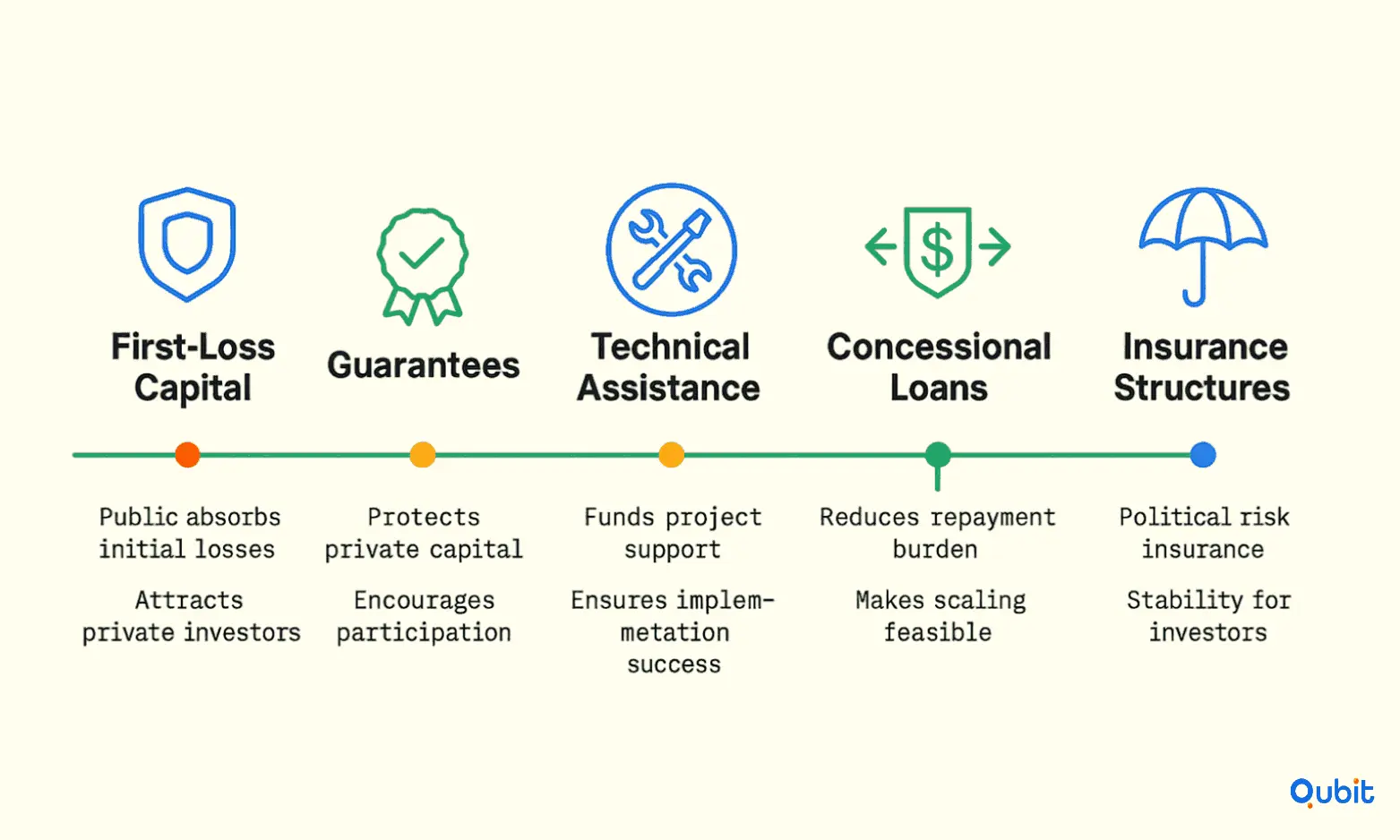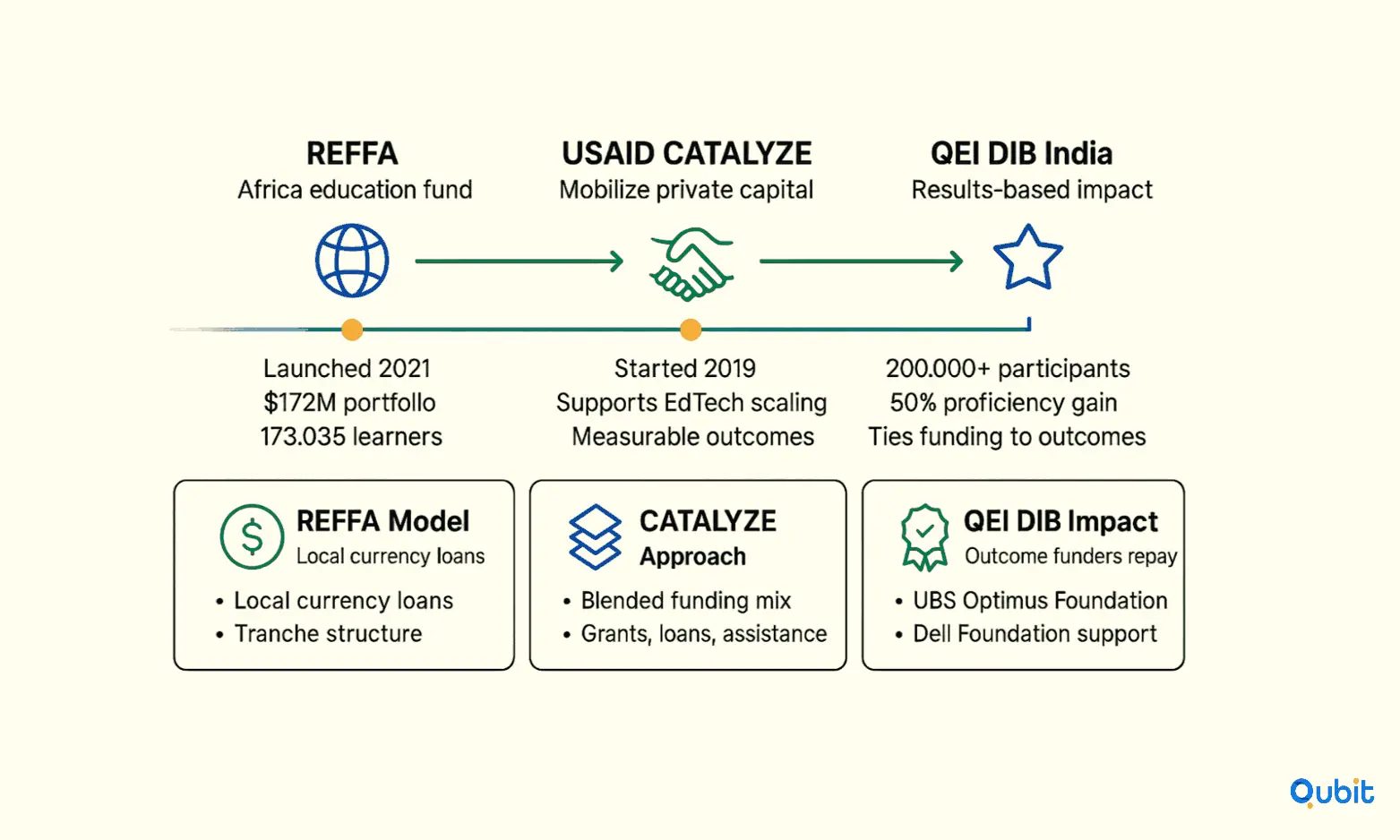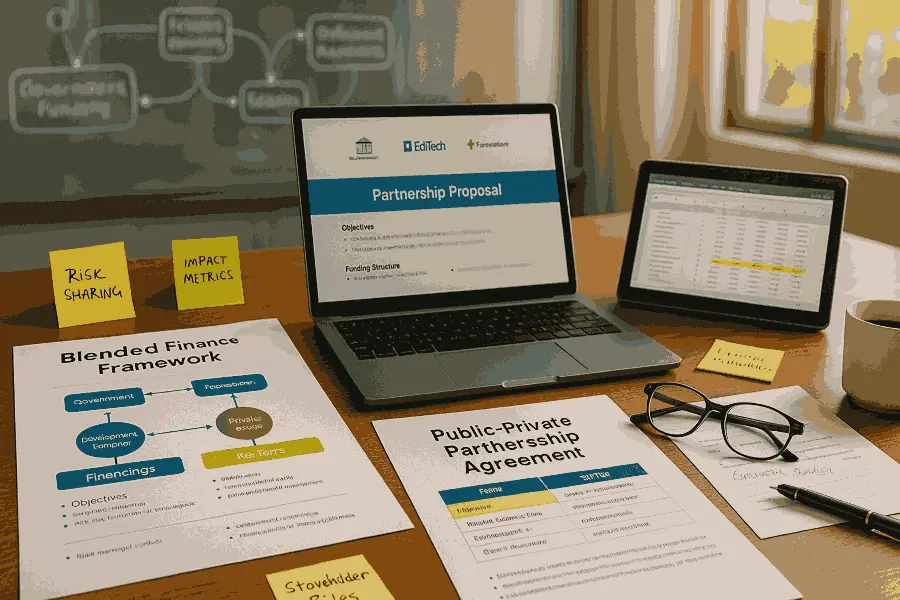Blended finance is reshaping the way we approach educational technology (EdTech) funding. By combining public, philanthropic, and private resources, this innovative model addresses the financial gaps that often hinder progress in education. It’s not just about pooling funds; it’s about creating sustainable solutions that amplify impact.
This blog will explore how blended finance is driving change in EdTech. We’ll examine its role in fostering collaboration, the benefits it brings to stakeholders, and the challenges it seeks to overcome. From improving access to education to ensuring long-term scalability, blended finance is proving to be a game-changer.
Let’s jump right in to uncover how this approach is revolutionizing the funding landscape for EdTech initiatives.
Understanding How Blended Finance Works in EdTech
Blended finance models are transforming how investments are made in the EdTech sector, creating opportunities for impactful growth. By combining public or philanthropic funds with private capital, these models aim to reduce risks and incentivize private sector participation in projects that might otherwise be deemed too uncertain or unprofitable.

Mechanisms Driving Blended Finance
Several financial instruments are used to make blended finance effective in EdTech:
- First-loss capital: Public or philanthropic entities absorb initial losses, reducing the risk for private investors and encouraging their involvement.
- Guarantees: These provide assurance to private investors that their capital will be protected against specific risks, fostering confidence in EdTech projects.
- Technical assistance: Support services, such as capacity building or project development, are funded to ensure the success of initiatives, making them more attractive to private investors.
- Concessional loans: Offered at below-market rates, these loans lower the financial burden on EdTech startups, enabling them to scale operations while attracting private capital.
- Insurance structures: Risk mitigation tools, such as political risk insurance, safeguard investments in volatile markets, ensuring stability for private stakeholders.
Catalyzing Private Investment
Blended finance models are particularly effective in addressing funding gaps in EdTech. For instance, according to The OECD DAC Blended Finance Guidance, establishing clear principles for private sector engagement can significantly improve project outcomes. These mechanisms not only attract private capital but also create a sustainable ecosystem for innovation in education technology.
For a broader perspective on funding strategies, explore how blended finance integrates with other approaches in how to raise funds for edtech startups. This resource complements the discussion by highlighting additional opportunities and challenges in EdTech fundraising.
DTC Framework Pillars for Structuring Blended Finance Success in EdTech
Achieving sustainable growth in EdTech through blended finance requires a structured approach. The DTC Framework pillars, coordination, infrastructure, capacity, content, and data, serve as essential building blocks for efficient governance and decision-making.
Coordination: Strengthening Leadership and Decision-Making
Effective coordination ensures that stakeholders align their goals and resources, fostering evidence-informed decision-making. Strong leadership within blended finance initiatives helps establish clear priorities, enabling EdTech projects to address critical challenges with precision.
Infrastructure: Building Scalable Connectivity
Robust infrastructure is the backbone of scalable EdTech solutions. Reliable connectivity and technological systems create the foundation for delivering educational tools to underserved communities. Without this pillar, even the most innovative projects risk falling short of their potential.
Capacity: Cultivating Skills for Long-Term Success
Capacity-building is vital for empowering educators, administrators, and students to maximize the benefits of EdTech. By fostering a culture of continuous learning and skill development, blended finance initiatives can ensure their impact extends far beyond initial implementation.
Content and Data: Driving Innovation and Accountability
High-quality content tailored to diverse learning needs is essential for EdTech success. Equally important is the integration of data-driven strategies, which enable stakeholders to measure outcomes, refine approaches, and maintain accountability. Together, these pillars create a dynamic ecosystem for innovation.
Sources of Capital: Where Does Blended Finance Funding Come From?
Blended finance brings together diverse funding sources to drive impactful initiatives, such as EdTech programs. These sources include government contributions, philanthropic grants, multilateral funding, and private sector investments, each playing a unique role in creating sustainable solutions.
Government Contributions
Government funding often serves as the foundation for blended finance models. It typically comes in the form of concessional capital or grants, which provide low-cost or no-cost financing to reduce risk for other investors. This type of funding is crucial for kickstarting projects that align with public policy goals, such as improving access to quality education.
Philanthropic Grants
Philanthropic organizations offer catalytic funding that is essential for initiating projects. These grants are designed to absorb early-stage risks, enabling innovative solutions to take root. For example, philanthropic contributions can support experimental EdTech models, ensuring they have the resources to prove their effectiveness before scaling.
Multilateral Contributions
Multilateral bodies, such as development banks, contribute both concessional and non-concessional resources. Their involvement often signals credibility and stability, attracting additional investors. These organizations may also provide technical expertise alongside funding, ensuring projects are well-structured and impactful.
Private Sector Investments
Private investors bring scalability to blended finance initiatives. While their primary focus is on achieving commercial returns, they are increasingly drawn to projects that align with social impact goals. For instance, private capital can support scalable educational models, such as the Learning Outcomes Incentive-Based Loan Product, which ties financial support to measurable student performance metrics.
Blended finance thrives on collaboration, combining the strengths of public, private, and philanthropic sectors to address global challenges. To explore additional funding pathways, consider examining alternative fundraising for edtech, which highlights non-traditional financing methods that complement blended finance approaches.
Challenges in Blended Finance for EdTech: Pitfalls to Avoid
Blended finance in the education sector offers promising opportunities, but it comes with significant challenges that can derail its effectiveness. One major hurdle is the limited evidence on educational outcomes, which complicates risk assessment for investors. Without robust data, it becomes difficult to predict the success of initiatives, leaving stakeholders hesitant to commit resources.
Another critical issue is the challenge of measuring impact, especially given the long-term nature of education benefits. Unlike sectors with immediate returns, education outcomes often take years to materialize, making it harder to evaluate the effectiveness of investments. This delay can deter private investors who prioritize quicker returns.
Misaligned incentives between private investors and educational goals further complicate blended finance models. While investors often focus on profitability, education initiatives aim to maximize social impact. This divergence can undermine projects if profit-driven motives overshadow the core mission of improving education access and quality. A review of edtech fundraising mistakes deepens your understanding by revealing common pitfalls, which provides context for refining blended finance strategies.
Finally, ethical and regulatory hurdles must be addressed to protect vulnerable populations. Education financing challenges often intersect with sensitive issues like data privacy, equitable access, and regulatory compliance. Missteps in these areas can lead to public backlash or legal complications, jeopardizing the sustainability of blended finance initiatives.
By understanding these pitfalls, stakeholders can better structure blended finance models that align with both investor expectations and educational goals.
Essential Resources for Blended Finance in EdTech
Staying informed about blended finance in EdTech requires access to reliable and comprehensive resources. Below is a curated selection of key blended finance resources that provide valuable insights, guidelines, and analytical perspectives from leading organizations.
Reports and Publications
- OECD Blended Finance Guidance: The Organisation for Economic Co-operation and Development (OECD) offers detailed frameworks and case studies on blended finance, emphasizing its role in achieving sustainable development goals.
- UN DESA Financing for Development Reports: The United Nations Department of Economic and Social Affairs (UN DESA) regularly publishes reports that explore innovative financing mechanisms, including blended finance, for advancing education and technology.
- IFC’s Blended Finance for Impact: The International Finance Corporation (IFC) provides in-depth analyses of blended finance structures, focusing on their application in emerging markets.
Guidelines and Regulatory Resources
For those navigating the legal aspects of blended finance, resources like the OECD’s policy briefs and the World Bank’s regulatory toolkits are indispensable. These materials clarify compliance requirements and help stakeholders align their initiatives with global standards. Additionally, insights on the legal aspects of edtech startup fundraising add depth to the conversation by clarifying regulatory considerations related to blended finance initiatives.
Analytical Tools and Case Studies
- Convergence Knowledge Library: This platform offers a wealth of case studies and data-driven insights on blended finance projects across various sectors, including EdTech.
- World Economic Forum Reports: The WEF provides thought leadership on innovative financing models, highlighting successful blended finance initiatives in education.
By leveraging these resources, stakeholders can better understand the complexities of blended finance and make informed decisions that drive impactful investments in EdTech.
Case Studies: Blended Finance Success Stories in EdTech
Real-world examples of blended finance in EdTech reveal how innovative funding models can create lasting change in underserved regions. Three standout cases below, illustrate the transformative potential of catalytic capital and structured financing.

1. Regional Education Finance Fund for Africa (REFFA)
REFFA is a pioneering blended finance initiative dedicated exclusively to the education sector in Africa. Launched in 2021 by the German Development Bank (KfW) with support from the German Federal Ministry for Economic Cooperation and Development (BMZ), REFFA aims to expand access to secondary, vocational, and higher education across the continent
How It Works:
REFFA pools capital from development finance institutions (DFIs) and private investors. The fund channels resources through local financial intermediaries, which then provide loans and technical assistance to education providers, students, and families. The fund is structured in three tranches, junior, mezzanine, and senior, offering different risk-return profiles to attract a wide range of investors.
Impact:
As of September 2023, REFFA’s portfolio exceeded $172 million, supporting 3,163 education providers and 173,035 learners across Africa. Loans, disbursed in local currency, ranged from $0.5 million to $5 million, making financing accessible to a diverse set of education stakeholders. By blending public and private capital, REFFA has demonstrated how innovative finance can drive both access and quality in education.
2. USAID CATALYZE EduFinance
USAID’s CATALYZE EduFinance program, launched in 2019, is another notable example of blended finance in EdTech. The initiative mobilizes private capital to support education enterprises and innovations, including digital learning platforms.
How It Works:
CATALYZE uses a combination of grants, concessional loans, and technical assistance to de-risk investments for private financiers. The program supports education providers in developing countries to scale up technology-enabled learning solutions, with a focus on improving access and outcomes for underserved populations.
Impact:
By leveraging blended finance, CATALYZE has enabled the expansion of EdTech companies and digital learning initiatives, particularly in markets where access to traditional capital is limited. The program’s structure ensures that funding is linked to measurable educational outcomes, incentivizing innovation and accountability.
3. India’s Quality Education India Development Impact Bond (QEI DIB)
The QEI DIB is the world’s largest education-focused Development Impact Bond, supporting Indian education providers in improving learning outcomes for primary school children.
How It Works:
Investors, such as the UBS Optimus Foundation, provide upfront capital to education service providers. Outcome funders, like the Michael & Susan Dell Foundation, reimburse investors with a return if agreed-upon improvements in literacy and numeracy are achieved. This results-based approach blends philanthropic and private capital, tying financial returns directly to educational impact.
Impact:
The QEI DIB has reached over 200,000 participants, with significant improvements in learning outcomes and a 50% higher rate of students achieving grade-level proficiency. The model has also promoted innovation in teaching and assessment, demonstrating the potential of blended finance to drive scalable, measurable change in EdTech and education delivery
Key Insights from These Success Stories
- All the case studies underscore the importance of blending public and private funding to address gaps in education financing.
- They also provide actionable insights into overcoming barriers such as limited access to capital and the need for scalable, sustainable solutions.
At Qubit Capital, we understand the complexities of securing funding for education-focused ventures. If you're ready to take your EdTech initiatives to the next level, reach out to us today for expert Fundraising Assistance. Together, we can help you secure the capital needed to bring quality education to every learner.
Enhancing Quality Education through Blended Finance: Strategic Initiatives
Blended finance is transforming the education sector by bridging funding gaps and enabling scalable solutions. Combining public and private resources, this innovative approach addresses challenges in improving access to EdTech funding while fostering impactful partnerships.
Public-Private Partnerships: A Catalyst for Change
Collaborations between governments and private entities are pivotal in driving educational progress. Public-private partnerships (PPPs) pool resources to fund initiatives that might otherwise remain underfunded. For example, governments can provide initial capital, while private investors contribute expertise and additional funding to scale projects. This synergy ensures that high-impact programs, such as digital learning platforms, reach underserved communities.
Innovative Financing Models
Blended finance introduces creative mechanisms to maximize impact. Results-based financing, for instance, ties funding to measurable outcomes, ensuring accountability and effectiveness. Similarly, impact bonds attract private investors by offering returns based on the success of educational programs. These models not only enhance transparency but also encourage sustainable investments in education.
Scaling EdTech Solutions
Access to technology in education remains a critical issue, particularly in low-income regions. Blended finance addresses this by channeling funds into EdTech initiatives that improve learning outcomes. By integrating digital tools into classrooms, students gain access to personalized learning experiences, bridging the gap between traditional education and modern needs.
Conclusion
The strategies explored throughout this blog highlight the transformative potential of blended finance in driving EdTech innovation. By combining resources from both public and private sectors, organizations can overcome funding barriers and scale impactful educational solutions. Strategic public-private partnerships play a pivotal role in ensuring that these initiatives not only reach underserved communities but also create sustainable, long-term benefits for learners worldwide.
If you’re assembling grants, concessional capital, and venture into one bankable stack, we turn policy and impact into investor-grade proof. Move forward with our edtech fundraising assistance. Request a blended-finance proposal!
Key Takeaways
- Blended finance combines diverse capital sources to accelerate EdTech innovation.
- Public-private partnerships mitigate risks and foster sustainable education outcomes.
- Clearly defined stakeholder roles and coordinated efforts are critical for project success.
- Outcome-based financing and technical assistance funds improve transparency and accountability.
- Real-world case studies demonstrate the practical effectiveness of blended finance models.
Frequently asked Questions
What is blended finance in EdTech?
Blended finance in EdTech combines public or philanthropic grants with private and institutional capital to fund educational technology projects that might otherwise struggle to secure purely commercial investment. For example, an EdTech startup might use a foundation grant to de-risk early R&D, attract venture capital for scale-up, and run a crowdfunding campaign to validate user demand






